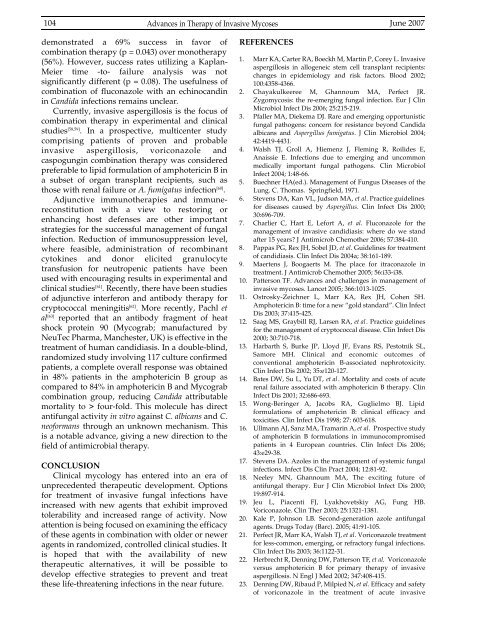Vol 39 # 2 June 2007 - Kma.org.kw
Vol 39 # 2 June 2007 - Kma.org.kw
Vol 39 # 2 June 2007 - Kma.org.kw
- No tags were found...
You also want an ePaper? Increase the reach of your titles
YUMPU automatically turns print PDFs into web optimized ePapers that Google loves.
104Advances in Therapy of Invasive Mycoses <strong>June</strong> <strong>2007</strong>demonstrated a 69% success in favor ofcombination therapy (p = 0.043) over monotherapy(56%). However, success rates utilizing a Kaplan-Meier time -to- failure analysis was notsignificantly different (p = 0.08). The usefulness ofcombination of fluconazole with an echinocandinin Candida infections remains unclear.Currently, invasive aspergillosis is the focus ofcombination therapy in experimental and clinicals t u d i e s [ 58 , 59 ] . In a prospective, multicenter studycomprising patients of proven and pro b a b l einvasive aspergillosis, voriconazole andcaspogungin combination therapy was consideredpreferable to lipid formulation of amphotericin B ina subset of <strong>org</strong>an transplant recipients, such asthose with renal failure or A. fumigatus infection [60] .Adjunctive immunotherapies and immunereconstitutionwith a view to restoring orenhancing host defenses are other importantstrategies for the successful management of fungalinfection. Reduction of immunosuppression level,w h e re feasible, administration of re c o m b i n a n tcytokines and donor elicited granulocytetransfusion for neutropenic patients have beenused with encouraging results in experimental andclinical studies [61] . Recently, there have been studiesof adjunctive interferon and antibody therapy forcryptococcal meningitis [62] . More recently, Pachl etal [63] reported that an antibody fragment of heatshock protein 90 (Mycograb; manufactured byNeuTec Pharma, Manchester, UK) is effective in thetreatment of human candidiasis. In a double-blind,randomized study involving 117 culture confirmedpatients, a complete overall response was obtainedin 48% patients in the amphotericin B group ascompared to 84% in amphotericin B and Mycograbcombination group, reducing Candida attributablemortality to > four-fold. This molecule has directantifungal activity in vitro against C. albicans and C.neoformans through an unknown mechanism. Thisis a notable advance, giving a new direction to thefield of antimicrobial therapy.CONCLUSIONClinical mycology has entered into an era ofunprecedented therapeutic development. Optionsfor treatment of invasive fungal infections haveincreased with new agents that exhibit improvedtolerability and increased range of activity. Nowattention is being focused on examining the efficacyof these agents in combination with older or neweragents in randomized, controlled clinical studies. Itis hoped that with the availability of newtherapeutic alternatives, it will be possible todevelop effective strategies to prevent and treatthese life-threatening infections in the near future.REFERENCES1. Marr KA, Carter RA, Boeckh M, Martin P, Corey L. Invasiveaspergillosis in allogeneic stem cell transplant recipients:changes in epidemiology and risk factors. Blood 2002;100:4358-4366.2. C h a y a k u l k e e ree M, Ghannoum MA, Perfect JR.Zygomycosis: the re-emerging fungal infection. Eur J ClinMicrobiol Infect Dis 2006; 25:215-219.3. Pfaller MA, Diekema DJ. Rare and emerging opportunisticfungal pathogens: concern for resistance beyond Candidaalbicans and Aspergillus fumigatus. J Clin Microbiol 2004;42:4419-4431.4. Walsh TJ, Groll A, Hiemenz J, Fleming R, Roilides E,Anaissie E. Infections due to emerging and uncommonmedically important fungal pathogens. Clin Micro b i o lInfect 2004; 1:48-66.5. Buechner HA(ed.). Management of Fungus Diseases of theLung. C. Thomas. Springfield, 1971.6. Stevens DA, Kan VL, Judson MA, et al. Practice guidelinesfor diseases caused by Aspergillus. Clin Infect Dis 2000;30:696-709.7. Charlier C, Hart E, Lefort A, et al. Fluconazole for themanagement of invasive candidiasis: where do we standafter 15 years? J Antimicrob Chemother 2006; 57:384-410.8. Pappas PG, Rex JH, Sobel JD, et al. Guidelines for treatmentof candidiasis. Clin Infect Dis 2004a; 38:161-189.9. Maertens J, Boogaerts M. The place for itraconazole intreatment. J Antimicrob Chemother 2005; 56:i33-i38.10. Patterson TF. Advances and challenges in management ofinvasive mycoses. Lancet 2005; 366:1013-1025.11. O s t rosky-Zeichner L, Marr KA, Rex JH, Cohen SH.Amphotericin B: time for a new “gold standard”. Clin InfectDis 2003; 37:415-425.12. Saag MS, Graybill RJ, Larsen RA, et al. Practice guidelinesfor the management of cryptococcal disease. Clin Infect Dis2000; 30:710-718.13. Harbarth S, Burke JP, Lloyd JF, Evans RS, Pestotnik SL,S a m o re MH. Clinical and economic outcomes ofconventional amphotericin B-associated nephro t o x i c i t y.Clin Infect Dis 2002; 35:e120-127.14. Bates DW, Su L, Yu DT, et al. Mortality and costs of acuterenal failure associated with amphotericin B therapy. ClinInfect Dis 2001; 32:686-693.15. Wong-Beringer A, Jacobs RA, Guglielmo BJ. Lipidformulations of amphotericin B: clinical efficacy andtoxicities. Clin Infect Dis 1998; 27: 603-618.16. Ullmann AJ, Sanz MA, Tramarin A, et al. Prospective studyof amphotericin B formulations in immunocompromisedpatients in 4 European countries. Clin Infect Dis 2006;43:e29-38.17. Stevens DA. Azoles in the management of systemic fungalinfections. Infect Dis Clin Pract 2004; 12:81-92.18. Neeley MN, Ghannoum MA, The exciting future ofantifungal therapy. Eur J Clin Microbiol Infect Dis 2000;19:897-914.19. Jeu L, Piacenti FJ, Lyakhovetskiy AG, Fung HB.Voriconazole. Clin Ther 2003; 25:1321-1381.20. Kale P, Johnson LB. Second-generation azole antifungalagents. Drugs Today (Barc). 2005; 41:91-105.21. Perfect JR, Marr KA, Walsh TJ, et al. Voriconazole treatmentfor less-common, emerging, or refractory fungal infections.Clin Infect Dis 2003; 36:1122-31.22. Herbrecht R, Denning DW, Patterson TF, et al. Voriconazoleversus amphotericin B for primary therapy of invasiveaspergillosis. N Engl J Med 2002; 347:408-415.23. Denning DW, Ribaud P, Milpied N, et al. Efficacy and safetyof voriconazole in the treatment of acute invasive
















